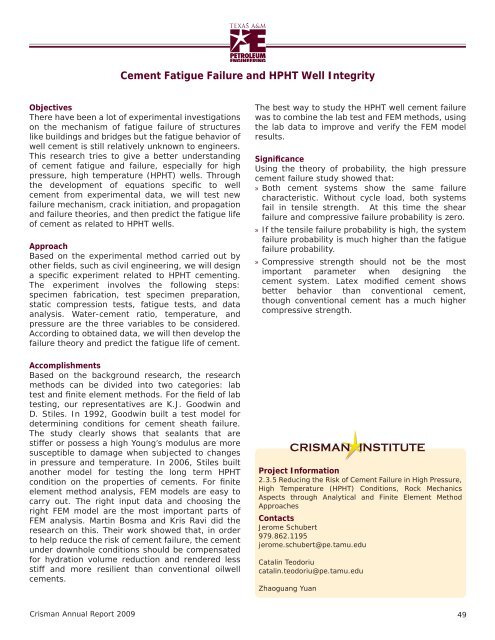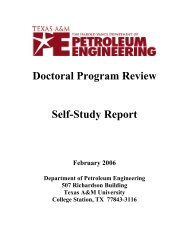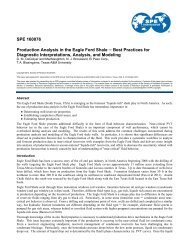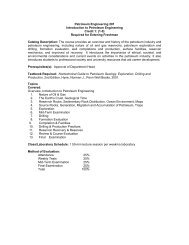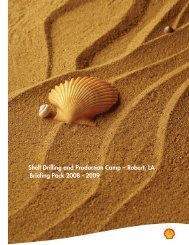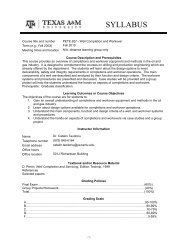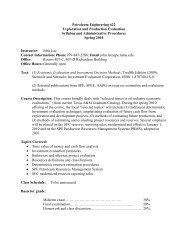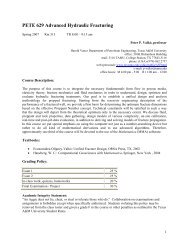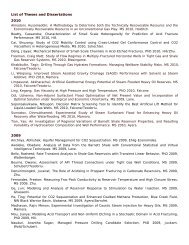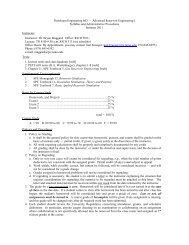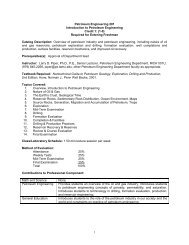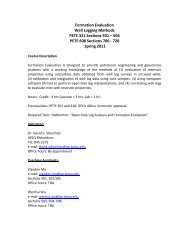Crisman Annual Report 2009 - Harold Vance Department of ...
Crisman Annual Report 2009 - Harold Vance Department of ...
Crisman Annual Report 2009 - Harold Vance Department of ...
Create successful ePaper yourself
Turn your PDF publications into a flip-book with our unique Google optimized e-Paper software.
Cement Fatigue Failure and HPHT Well Integrity<br />
Objectives<br />
There have been a lot <strong>of</strong> experimental investigations<br />
on the mechanism <strong>of</strong> fatigue failure <strong>of</strong> structures<br />
like buildings and bridges but the fatigue behavior <strong>of</strong><br />
well cement is still relatively unknown to engineers.<br />
This research tries to give a better understanding<br />
<strong>of</strong> cement fatigue and failure, especially for high<br />
pressure, high temperature (HPHT) wells. Through<br />
the development <strong>of</strong> equations specific to well<br />
cement from experimental data, we will test new<br />
failure mechanism, crack initiation, and propagation<br />
and failure theories, and then predict the fatigue life<br />
<strong>of</strong> cement as related to HPHT wells.<br />
Approach<br />
Based on the experimental method carried out by<br />
other fields, such as civil engineering, we will design<br />
a specific experiment related to HPHT cementing.<br />
The experiment involves the following steps:<br />
specimen fabrication, test specimen preparation,<br />
static compression tests, fatigue tests, and data<br />
analysis. Water-cement ratio, temperature, and<br />
pressure are the three variables to be considered.<br />
According to obtained data, we will then develop the<br />
failure theory and predict the fatigue life <strong>of</strong> cement.<br />
Accomplishments<br />
Based on the background research, the research<br />
methods can be divided into two categories: lab<br />
test and finite element methods. For the field <strong>of</strong> lab<br />
testing, our representatives are K.J. Goodwin and<br />
D. Stiles. In 1992, Goodwin built a test model for<br />
determining conditions for cement sheath failure.<br />
The study clearly shows that sealants that are<br />
stiffer or possess a high Young’s modulus are more<br />
susceptible to damage when subjected to changes<br />
in pressure and temperature. In 2006, Stiles built<br />
another model for testing the long term HPHT<br />
condition on the properties <strong>of</strong> cements. For finite<br />
element method analysis, FEM models are easy to<br />
carry out. The right input data and choosing the<br />
right FEM model are the most important parts <strong>of</strong><br />
FEM analysis. Martin Bosma and Kris Ravi did the<br />
research on this. Their work showed that, in order<br />
to help reduce the risk <strong>of</strong> cement failure, the cement<br />
under downhole conditions should be compensated<br />
for hydration volume reduction and rendered less<br />
stiff and more resilient than conventional oilwell<br />
cements.<br />
The best way to study the HPHT well cement failure<br />
was to combine the lab test and FEM methods, using<br />
the lab data to improve and verify the FEM model<br />
results.<br />
Significance<br />
Using the theory <strong>of</strong> probability, the high pressure<br />
cement failure study showed that:<br />
» Both cement systems show the same failure<br />
characteristic. Without cycle load, both systems<br />
fail in tensile strength. At this time the shear<br />
failure and compressive failure probability is zero.<br />
» If the tensile failure probability is high, the system<br />
failure probability is much higher than the fatigue<br />
failure probability.<br />
» Compressive strength should not be the most<br />
important parameter when designing the<br />
cement system. Latex modified cement shows<br />
better behavior than conventional cement,<br />
though conventional cement has a much higher<br />
compressive strength.<br />
Project Information<br />
2.3.5 Reducing the Risk <strong>of</strong> Cement Failure in High Pressure,<br />
High Temperature (HPHT) Conditions, Rock Mechanics<br />
Aspects through Analytical and Finite Element Method<br />
Approaches<br />
Contacts<br />
Jerome Schubert<br />
979.862.1195<br />
jerome.schubert@pe.tamu.edu<br />
Catalin Teodoriu<br />
catalin.teodoriu@pe.tamu.edu<br />
Zhaoguang Yuan<br />
CRISMAN INSTITUTE<br />
<strong>Crisman</strong> <strong>Annual</strong> <strong>Report</strong> <strong>2009</strong><br />
49


